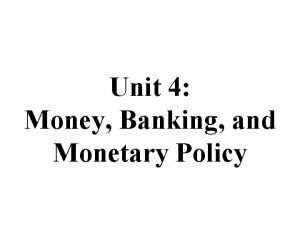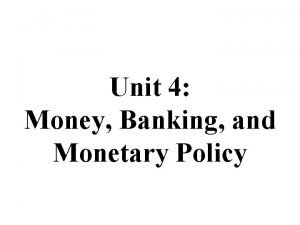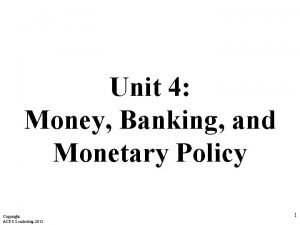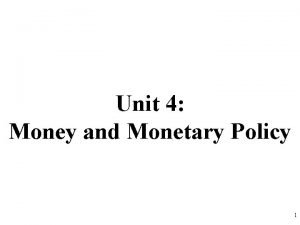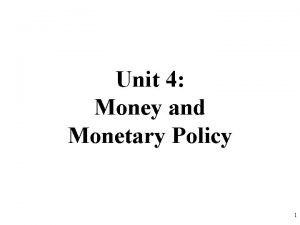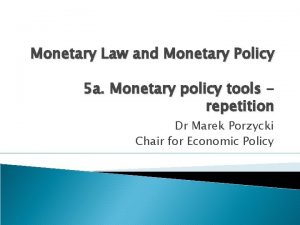Monetary Law and Monetary Policy 5 a Monetary







- Slides: 7

Monetary Law and Monetary Policy 5 a. Monetary policy tools repetition Dr Marek Porzycki Chair for Economic Policy

Situation 1 Following a 6 -year period of high economic growth (averaging 5% of GDP), inflation has risen above 4% and is predicted to remain high. Growth of asset prices (real estate, shares in companies) was consistently above inflation. During last 2 years real estate prices grew in average by 25%. You are a member of the body deciding on the monetary policy (e. g. Monetary Policy Council). What steps would you advise to your colleagues?

Situation 2 A sudden spike in global oil prices caused inflation to rise to 4% in the last quarter (Q 1). Further rise to 5% is expected in the next two quarters (Q 2 and Q 3). The economy remained stagnant with growth rate (annualised) at 0, 7% of GDP in Q 1, predicted to fall to 0, 1 -0, 3% in Q 2 and Q 3.

Situation 3 Economic growth slowed down from 3% of GDP to 1, 8% and is expected to fall further because of weak results in neighbouring economies depressing export profits. Inflation rate of 4, 5% is still above the target of 2, 5% but it is expected to fall.

Situation 4 A credit boom ended with a sudden fall in real estate prices. Risk on loans granted by banks increased significantly, as they were not anymore covered by the value of real estate used as collateral. Resulting doubts over long -term solvency of banks caused interbank lending to freeze. Inflation level was 4% and growing before the fall of real estate prices. Since the credit crunch inflation rapidly fell to below 2%.

Situation 5 2 years after an economic crisis and recession the economy has started a very slow recovery. Economy growth in Q 1 was 0, 4%, in Q 2 1, 2%, in Q 3 0, 8%. According to analysts, recession is likely in Q 4 and the following year. Inflation is persistently around 0%, with some periods of deflation (Q 1 -0, 1%; Q 2 0, 6%; Q 3 0, 2%). Central bank deposit rate is at 0, 10%, lending rate at 0, 50%.

Situation 6 After an economic slowdown and subsequent recesssion the central bank engaged in several rounds of quantitative easing, significantly expanding the monetary base. In parallel, the government has increased spending, intending to boost the economy with a stimulus package. Most recently, the economic growth increased to 2, 5% and inflation started to grow, reaching 2%. Banks reported increased lending. Prices on real estate market started to grow dynamically, in average by 7% in the last two quarters.
